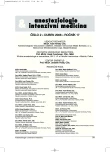-
Medical journals
- Career
Echocardiography in the critically ill patient
Authors: M. Balík
Authors‘ workplace: Klinika anesteziologie a resuscitace, Fakultní nemocnice Královské Vinohrady, Praha
Published in: Anest. intenziv. Med., 17, 2006, č. 2, s. 116-122
Category: Intensive Medicine
Overview
Availability of an ultrasound device in the critical care setting significantly extends diagnostic options and makes the management of critically ill patients more effective. A growing amount of papers confirm that qualified intensivists can provide accurate, safe and extensive diagnosis of the haemodynamic system with the aid of echocardiography. Intensivists involved in the management of the critically ill are fully aware of all patient’s clinical and laboratory data and they should be able to interpret the echocardiographic examination in a complex manner and with immediate application for further therapy. Performing echocardiography in the intensive care unit requires on the other hand thorough knowledge of the devices and principles of heart ultrasound. Task forces within societies of intensive care and cardiology launched curriculla for training and data acquisition in echocardiography in the last three years. A complex echocardiographic exam of the critically ill patient should include following items: preload, global and segmental contractility, diastolic function, afterload, examination of the valvular apparatus, cardiac output, right heart including the pulmonary artery and pulmonary artery pressure, aortic pathology, the pericardium and examination of the pleural space. 10–11 planes should be taken during a routine transthoracic examination and 12 planes during transesophageal echocardiography. Utilisation of an ultrasonic device should not be limited to echocardiography. Examination of the pleural space, quantification of the pleural fluid and an eventual exclusion of a ventral pneumothorax with the aid of a transthoracic probe should be an integral part of a transthoracic echocardiographic examination. A multimodal ultrasonic device equipped with a transesophageal probe should be available in all large intensive care units where its presence would be justified by a high number of diagnosed and treated patients. This is also related to savings on pulmonary artery catheters, X-ray material and platelet transfusions, besides the immediate and almost complete diagnosis of the cardiovascular system.
Key words:
echocardiography – transesophageal echocardiography – monitoring – critical care
Labels
Anaesthesiology, Resuscitation and Inten Intensive Care Medicine
Article was published inAnaesthesiology and Intensive Care Medicine

2006 Issue 2-
All articles in this issue
- What was new in general anaesthesia last year? Literature review
- New developments in regional anaesthesia in 2005
- Cardiac anaesthesia in 2005
- What’s new in the pharmacotherapy of pain?
- Vasopressors in septic shock – 2005 update
- Progress in the pathophysiology and therapy of ventilatory failure in critically ill patients
- Progress in the prevention, diagnosis and therapy of nosocomial ventilatory pneumonia in 2005
- Renal replacement therapy in critically ill patients: 2005 update
- Metabolism, endocrinology, and nutrition: Progress in 2005
- Therapy of brain injury
- Echocardiography in the critically ill patient
- Guidelines 2005: What is different compared with Guidelines 2000?
- Anaesthesiology and Intensive Care Medicine
- Journal archive
- Current issue
- Online only
- About the journal
Most read in this issue- Vasopressors in septic shock – 2005 update
- What’s new in the pharmacotherapy of pain?
- Echocardiography in the critically ill patient
- Renal replacement therapy in critically ill patients: 2005 update
Login#ADS_BOTTOM_SCRIPTS#Forgotten passwordEnter the email address that you registered with. We will send you instructions on how to set a new password.
- Career

